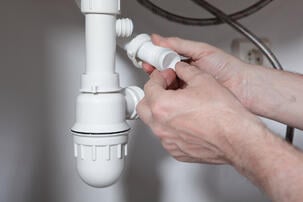Any individual is bound to have their personal thinking with regards to How Does the Plumbing Work in Your Home?.

Plumbing is an important facet of any home, responsible for providing tidy water for alcohol consumption, cooking, and bathing, in addition to getting rid of wastewater securely. Recognizing the essentials of home plumbing is essential for every property owner to ensure correct maintenance, troubleshooting, and, if necessary, repair work. In this beginner's guide, we'll cover the fundamental principles of home plumbing to assist you become extra familiar with just how it works.
Water Heating System
The water heating system is responsible for home heating water for domestic usage, consisting of bathing, cooking, and cleansing. Common sorts of water heaters include tank-type hot water heater, tankless (on-demand) water heaters, and heat pump hot water heater. The hot water heater is attached to the supply of water system and provides warm water to plumbing fixtures as required.
Water drainage System
The drainage system eliminates wastewater from your home and brings it away to a sewage treatment center or septic system. It contains a network of pipelines, fittings, and fixtures that transport wastewater from plumbing fixtures to the primary sewage system line or septic tank. Appropriate drain is vital to protect against clogs, back-ups, and sewer leakages.
Ventilation System
The ventilation system assists keep proper air pressure and protect against sewer gases from entering your home. Vent pipes, additionally referred to as air vent heaps, extend from plumbing fixtures to the roof covering, enabling sewer gases to run away securely outside. Air flow pipelines additionally allow air to go into the water drainage system, facilitating smooth wastewater flow and avoiding suction or vacuum effects.
Supply Of Water System
The supply of water system brings tidy water right into your home from a municipal water resource or a private well. It includes a primary water line that attaches to your home's plumbing system, usually located underground. A water meter determines the quantity of water taken in, while a shut-off valve allows you to control the flow of water into your home.
Plumbing Fixtures
Plumbing fixtures are tools that provide water to different parts of your home and include sinks, taps, bathrooms, showers, bathtubs, and appliances such as dishwashers and cleaning devices. Each fixture is attached to the water system system via pipelines and fittings and may have its shut-off valve for maintenance or emergency situations.
Usual Plumbing Tools
Having the right tools accessible is essential for executing fundamental plumbing repair services and maintenance jobs. Typical plumbing tools include adjustable wrenches, monkey wrench, pliers, pipe cutters, hacksaws, bettors, augers (or drain snakes), and Teflon tape. Having these tools conveniently offered can help you deal with minor plumbing concerns effectively.
Basic Plumbing Repair Work
While some plumbing repairs might need specialist help, numerous usual issues can be resolved with fundamental do it yourself techniques. Understanding how to deal with a leaky tap, unclog a drainpipe, change a bathroom flapper, or fix a trickling showerhead can save you money and time on plumbing repairs.
Final thought
Comprehending the essentials of home plumbing is necessary for every house owner to keep a safe, useful, and efficient plumbing system. By familiarizing yourself with the water system, plumbing fixtures, drain system, ventilation system, typical plumbing tools, and fundamental fixings, you can with confidence deal with minor plumbing issues and guarantee your home's plumbing system runs smoothly.
Understanding Basics of Home Plumbing System: A Beginner's Guide
The Main Components of Your Home Plumbing System
The Water Supply System
This system is responsible for transporting fresh water into your home. It usually has a main water line that splits into two branches: one directed towards cold water services and the other connected to a water heater for hot water. The pressure is key here; it ensures water reaches all parts of your house.
The Drainage System
Once water has been used, it becomes wastewater that needs to be removed from your home. This is where the drainage system comes into play. It includes all the pipes that carry wastewater and sewage away from your house to sewage treatment facilities or septic tanks.
The Vent System
The vent system prevents sewer gases from entering your home and helps maintain the pressure balance that allows wastewater to flow out properly. These vents usually exit through the roof of your house.
Water Heating System
For those who enjoy hot showers or using hot water for cleaning, the water heater is a crucial part of the plumbing system. It can be a tankless system, which heats water on demand, or a traditional water tank model.
Common Plumbing Problems and Basic Troubleshooting
Plumbing systems, while designed to be durable, can face issues like clogged drains, leaky faucets, or low water pressure. Here are some basic troubleshooting tips:
Clogged Drains
Use a plunger or a plumber's snake to try and dislodge whatever is blocking the drain. Regular cleaning can prevent clogs.
Leaky Faucets
Often caused by worn-out washers or gaskets, these can usually be replaced by someone with basic DIY skills.
Low Water Pressure
This might be due to sediment build-up in your fixtures or a leak somewhere in your water line. Cleaning out aerators or seeking a professional to detect leaks might be necessary.
Preventive Maintenance Tips
Maintaining your plumbing system is key to avoiding emergencies. Regularly check for leaks, avoid disposing of grease down the sink, and have your system inspected by a professional plumber at least once a year.

We had been made aware of that editorial on Understanding the Basics of Your Home's Plumbing System from someone on our other web address. Are you aware of somebody else who is curious about the topic? Why not share it. Thanks a bunch for your time. Kindly come visit our blog back soon.
Call Today